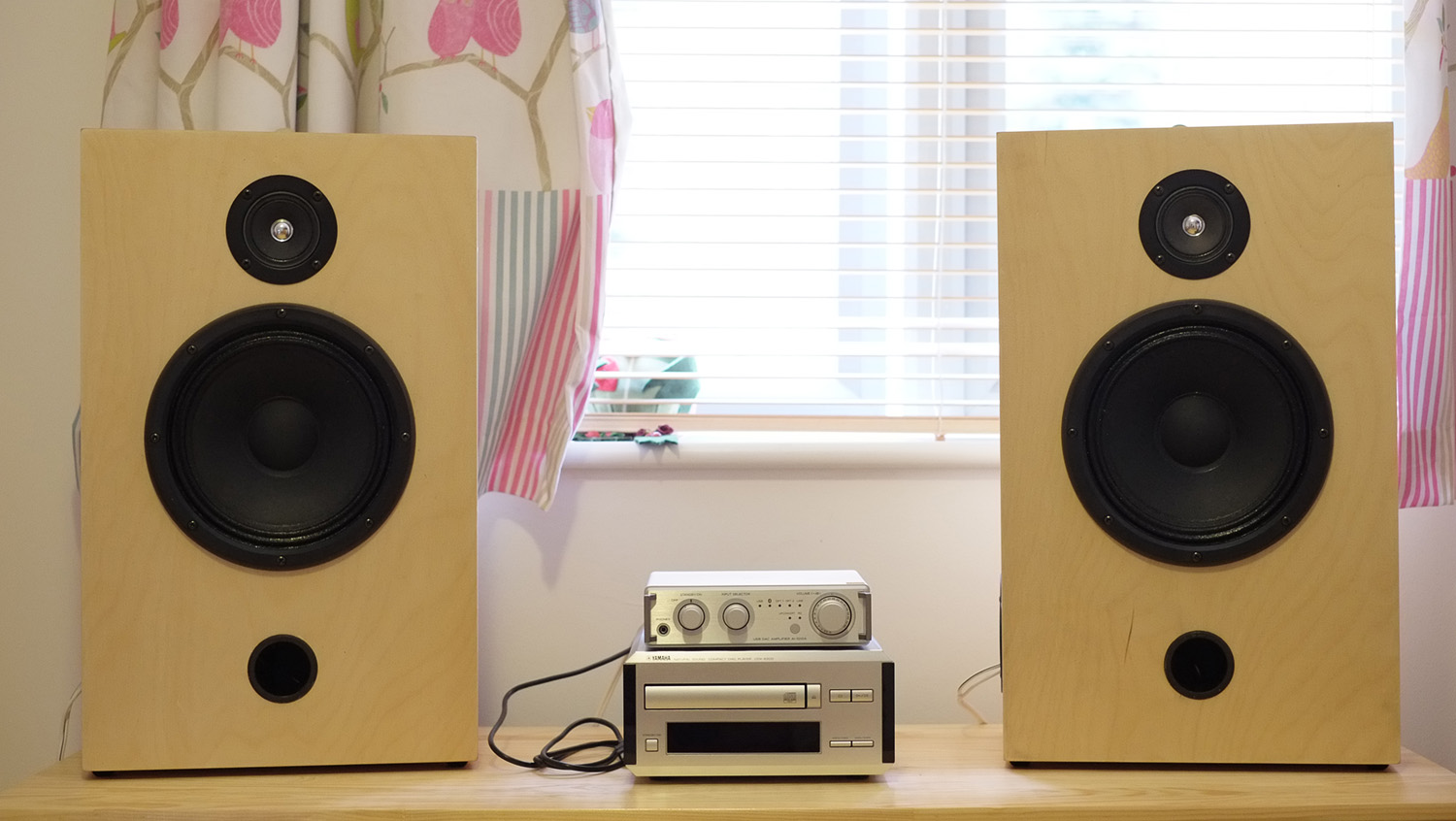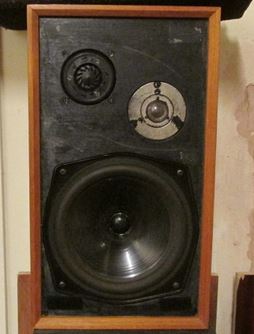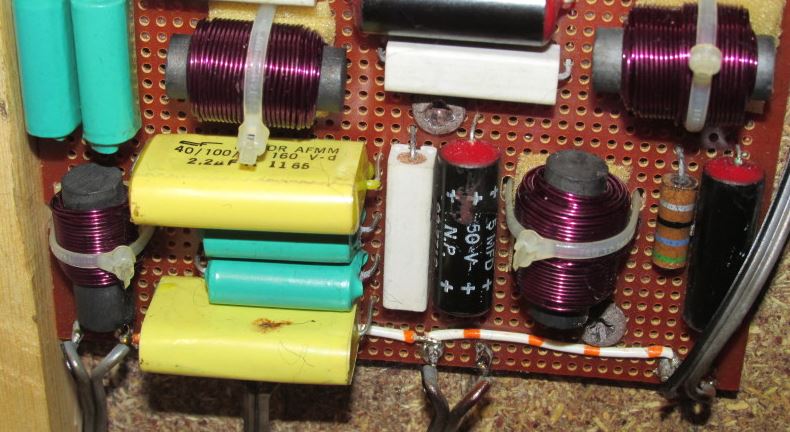Faithintruth, this thread is really designed to inspire people to a particular implementation of a speaker.
There's evidently a lot of ways to skin a cat. 😀
The Pi 4 and JBL L300 are high efficiency, high dynamics sort of speakers. I'd be extremely interested to hear a brief precis of how they work, and what sort of crossovers they have.
I was listening to some two way Mackie SRM450 active disco speakers tonight. Not an extended listening test, but I thought they had outstanding intelligibility on female vocals. Far better than most speakers I hear at our venue.
SRM Series
There's evidently a lot of ways to skin a cat. 😀
The Pi 4 and JBL L300 are high efficiency, high dynamics sort of speakers. I'd be extremely interested to hear a brief precis of how they work, and what sort of crossovers they have.
I was listening to some two way Mackie SRM450 active disco speakers tonight. Not an extended listening test, but I thought they had outstanding intelligibility on female vocals. Far better than most speakers I hear at our venue.
SRM Series
Attachments
Last edited:
Steve
I got excited and spewed out a couple speaker names. Indeed the JBL is a classic, although its implementation or reinterpretation is probably impossible as the tweeter and midrange diffuser are proprietary. Off the mark on that one. On the other hand the Pi 4 probably can't be considered classic but its 2 way config. ( albeit with a little more than a minimal crossover than what you were comparing to in an early post) bears some consideration. I thought also of an other poster's mention of point source, off axis listening challenges etc. so why not "remember" constant directivity horns and their compression drivers. I have been listening to these at every concert and dance since 75. Surely there will be some backs up if we start down the pro speaker road....in my mind a classic isn't always a Rogers, Harbeth, Kef or Spendor.
I guess my personal experience with JBL, EV, Peavy, Danley, Community and Wharfdale 15" woofer + horn tweeter combos got me thinking about Econowaves, various Altecs and Klipsch Horns and why this kind of speaker may or may not be popular to add here. Given that I have only started building speakers recently I'm not about to comment on crossover implementation. Just excited is all about learning about what could even be considered classic. It's nice to know that when folks stray off the path, a moderator is handy to re-direct the thread.
Thanks for adding your comprehensive knowledge of so many speakers; you seem to have owned many different models and brands....or read about them anyhow.
If I'm successful at completing my high efficiency 2-ways, I'll certainly post which cross-over parameters were implemented. I like the idea of the AN 2-ways, Orangutans (you mentioned and I have listened to many times) the Pi 4's, Econowaves, Geddes horns....maybe some builders here will chime in with their experiences at
replicating such a style.
Sorry for an empty posting...just trying to suggest a different flavour.
I got excited and spewed out a couple speaker names. Indeed the JBL is a classic, although its implementation or reinterpretation is probably impossible as the tweeter and midrange diffuser are proprietary. Off the mark on that one. On the other hand the Pi 4 probably can't be considered classic but its 2 way config. ( albeit with a little more than a minimal crossover than what you were comparing to in an early post) bears some consideration. I thought also of an other poster's mention of point source, off axis listening challenges etc. so why not "remember" constant directivity horns and their compression drivers. I have been listening to these at every concert and dance since 75. Surely there will be some backs up if we start down the pro speaker road....in my mind a classic isn't always a Rogers, Harbeth, Kef or Spendor.
I guess my personal experience with JBL, EV, Peavy, Danley, Community and Wharfdale 15" woofer + horn tweeter combos got me thinking about Econowaves, various Altecs and Klipsch Horns and why this kind of speaker may or may not be popular to add here. Given that I have only started building speakers recently I'm not about to comment on crossover implementation. Just excited is all about learning about what could even be considered classic. It's nice to know that when folks stray off the path, a moderator is handy to re-direct the thread.
Thanks for adding your comprehensive knowledge of so many speakers; you seem to have owned many different models and brands....or read about them anyhow.
If I'm successful at completing my high efficiency 2-ways, I'll certainly post which cross-over parameters were implemented. I like the idea of the AN 2-ways, Orangutans (you mentioned and I have listened to many times) the Pi 4's, Econowaves, Geddes horns....maybe some builders here will chime in with their experiences at
replicating such a style.
Sorry for an empty posting...just trying to suggest a different flavour.
Here is the fairly comprehensive manual for a classic european monitor:
ftp://ftp.studer.ch/public/products/Miscellaneous/A723/Manuals/A723_Op_Serv.pdf
ftp://ftp.studer.ch/public/products/Miscellaneous/A723/Manuals/A723_Op_Serv.pdf
Up and running at last!
OK, I have finally found the time to actually build these.
I measured the driver responses myself with HOLMImpulse, and optimized the crossover a bit, using available parts from my parts bin.
All caps are Jantzen MKP, and the one on the tweeter's high-pass is even a Superior Z-Cap which is totally overkill for this project... but I had a couple of these lying around and so I figured what the heck, I may just as well put them to good use ;-)
Both coils are air core, and the one on the woofer's low-pass has an intentionally highish Rs = 0.9 Ohm to bring up the Qe of the Woofer a bit and obtain a flatter response down to 50 Hz.
In attachment:
1) The simulated bass-reflex response
2) The measured FRs of the woofer
3) The measured FRs of the tweeter
4) The final optimized crossover schematic
5) The resulting 1/12-octave smoothed freq. and phase responses
6) The 1/6-octave smoothed response
7) The open box, with the drivers and crossover installed (the back is removable, like in many classic monitors of the '60s and '70s)
8) The final system as it is intended to be put together, on a temporary test bench.
All in all, it's been a fun experiment, and the sound is very good for what it cost.
In particular, the real 92dB/2.83V(m) sensitivity is nice to have, and the cone tweeter, with its larger Sd vs. the typical 1" dome, makes for a better dynamic match with the woofer.
Cheers,
Marco
Hi all,
inspired by this thread, I have decided to have a go at modelling and actually building a 2-way 'monitor' of this type for a friend, as follows:
Since these will be installed directly on the front wall (of a nice octagonal room, which results in the two speakers almost perfectly aimed at the listening position), no baffle-step compensation is required, retaining the full ~92dB sensitivity, which is nice.
- 8" Woofer: Mivoc WM-8 (92 dB/2.83V/1m, high Qms)
- cone tweeter: Monacor HT-22 (91 dB/2.83V/1m)
- box: 24L bass-reflex tuned to 50 Hz
- crossover: 2nd order electrical, phase matched (see simulation below)
I'll keep you all posted as I actually start assembling this in the Summer months...
Cheers,
Marco
OK, I have finally found the time to actually build these.
I measured the driver responses myself with HOLMImpulse, and optimized the crossover a bit, using available parts from my parts bin.
All caps are Jantzen MKP, and the one on the tweeter's high-pass is even a Superior Z-Cap which is totally overkill for this project... but I had a couple of these lying around and so I figured what the heck, I may just as well put them to good use ;-)
Both coils are air core, and the one on the woofer's low-pass has an intentionally highish Rs = 0.9 Ohm to bring up the Qe of the Woofer a bit and obtain a flatter response down to 50 Hz.
In attachment:
1) The simulated bass-reflex response
2) The measured FRs of the woofer
3) The measured FRs of the tweeter
4) The final optimized crossover schematic
5) The resulting 1/12-octave smoothed freq. and phase responses
6) The 1/6-octave smoothed response
7) The open box, with the drivers and crossover installed (the back is removable, like in many classic monitors of the '60s and '70s)
8) The final system as it is intended to be put together, on a temporary test bench.
All in all, it's been a fun experiment, and the sound is very good for what it cost.
In particular, the real 92dB/2.83V(m) sensitivity is nice to have, and the cone tweeter, with its larger Sd vs. the typical 1" dome, makes for a better dynamic match with the woofer.
Cheers,
Marco
Attachments
What does the FR look like if you switch the tweeter polarity?
Here you go:
Attachments
Aw guys, you're walking straight past Pure Gold here and not noticing! 😱

What a stunner. High efficiency, simple construction, simple crossover, low cost. And a cone tweeter that I've never seen employed in this way before!
I need to hear these babies. Better still I'm gonna clone them. Knockout. Well done Marco, and thanks for sharing!

What a stunner. High efficiency, simple construction, simple crossover, low cost. And a cone tweeter that I've never seen employed in this way before!
I need to hear these babies. Better still I'm gonna clone them. Knockout. Well done Marco, and thanks for sharing!

Hi, the suckout looks wierd with the tweeter connections reversed ? I might have expected the response to improve. Maybe it would if the xover values were changed ?
Plus raw graphs without smoothing might reveal more in general 😉
Regards
Plus raw graphs without smoothing might reveal more in general 😉
Regards
Hi, the suckout looks wierd with the tweeter connections reversed ? I might have expected the response to improve. Maybe it would if the xover values were changed ?
Plus raw graphs without smoothing might reveal more in general 😉
Regards

An interesting point about the null in Marco's splendidly original speaker, which I investigated. I found that bringing the tweeter forwards a centimetre improved things in my project along with about 10% change in resistors.
That's like mounting the woofer on the back of the baffle. Very BBC and Harbeth! Interesting. It looks pretty. Whether you hear it, IDK! 😎
Attachments

An interesting point about the null in Marco's splendidly original speaker, which I investigated. I found that bringing the tweeter forwards a centimetre improved things in my project along with about 10% change in resistors.
That's like mounting the woofer on the back of the baffle. Very BBC and Harbeth! Interesting. It looks pretty. Whether you hear it, IDK! 😎
Yes, adjusting the offset between the woofer and tweeter and slightly re-working the crossover would improve phase matching a bit. I didn't do it because I wanted to keep things as simple as possible and avoid a stepped baffle. The Mivoc WM-8 doesn't lend itself too well to back-mounting BTW, because it has a bevelled frame.
M.
Last edited:
I make no criticism of what you did here Marco. High efficiency 8" woofers tend to be rough above 2kHz. And flat baffle is easy to build. 🙂
With a lower efficiency and smoother woofer with steep natural rolloff, you can use a third order cone tweeter filter, negative polarity and cross at 3kHz. Phase lines up rather well. Which is where I've been going myself up till now, either LR4 or BW3. Below.
The Technics SB-4000 "Linear Phase" below is a stepped baffle not dissimilar to what you have done, just a couple of centimetres recess. It's an interesting approach on second order filters. I give you some sim plots. FWIW, you could get the phase almost perfect with an LCR on the 1.5kHz Fs resonance of the tweeter.
Old Japanese speakers always look a bit agricultural and "Kabuki", but there is a lot to like in them. Sony, for instance, used superb old SEAS lively high Qms drivers. Don't throw them away! 😎
With a lower efficiency and smoother woofer with steep natural rolloff, you can use a third order cone tweeter filter, negative polarity and cross at 3kHz. Phase lines up rather well. Which is where I've been going myself up till now, either LR4 or BW3. Below.
The Technics SB-4000 "Linear Phase" below is a stepped baffle not dissimilar to what you have done, just a couple of centimetres recess. It's an interesting approach on second order filters. I give you some sim plots. FWIW, you could get the phase almost perfect with an LCR on the 1.5kHz Fs resonance of the tweeter.
Old Japanese speakers always look a bit agricultural and "Kabuki", but there is a lot to like in them. Sony, for instance, used superb old SEAS lively high Qms drivers. Don't throw them away! 😎
Attachments
Last edited:
You get away with it because the time alignment error on flat baffle 8" bass, about 5 cm at 3kHz, is half a wavelength. So you flip the tweeter polarity and it all lines up again. Very BBC.@ system7
Yes that is interesting. Usually it's the other way round, to time align coils etc !
I built and tested a marco-gea clone with second order on the Monacor HT-22/8 today.
It's very good. Those £6 tweeters are amazing. Tried Carpenters, Diana Krall, Ella and Louis, Kacey Musgraves, Dawes, Chris Rea. If you have ever heard the popular old Wharfedale Linton pictured below, this is a homage to it IMO.
TBH, I think I prefer the KEF-type 90 degree phase BW3 sound which has better dispersion and steeper rolloff giving a cleaner sound that works off-axis too, but really what not to like about marco's simple design?
Vocals project extremely well. It's an involving sound and I'm enjoying listening to them, which is always a strength of low order filters. 🙂
Attachments
A fun find by charlie2 for a mere £33! 🙂
A three way 1980's kit monitor from Wilmslow Audio who are still going strong.


It's a Spendor BC1 clone, by the look of it.
KEF B200 bextrene cone, the Celestion HF1300 compression driver coming in around 1.5kHz, and a Coles supertweeter above 7kHz. Three ways avoided 25% luxury purchase tax, being considered professional.
Very much in the vogue, back in the day, and extremely good for classical music.
A three way 1980's kit monitor from Wilmslow Audio who are still going strong.


It's a Spendor BC1 clone, by the look of it.
KEF B200 bextrene cone, the Celestion HF1300 compression driver coming in around 1.5kHz, and a Coles supertweeter above 7kHz. Three ways avoided 25% luxury purchase tax, being considered professional.
Very much in the vogue, back in the day, and extremely good for classical music.
Just finished Troels's SEAS 3-Way Classic Mk2s. I hope to report on them once I have had a good listen.
Alex
Alex
Just finished Troels's SEAS 3-Way Classic Mk2s. I hope to report on them once I have had a good listen.
Alex
Congrats on finishing your speakers Alex. Looking forward to your report on the MKIIs. 🙂
Troels has posted my summary of my SEAS 3WC build and some photos on his site here. i will put a longer report on the project online in due course when I have had more time to evaluate them, and hopefully do some measurements of my own.
In short, I am very pleased with how they have turned out.
Alex
In short, I am very pleased with how they have turned out.
Alex
- Home
- Loudspeakers
- Multi-Way
- Classic monitor designs?
























